#software defined infrastructure
Text
Optimizing Operations with Network Automation: Best Practices and Solutions

Network Automation is a game-changer in the realm of IT operations, offering a plethora of benefits for optimizing network management tasks. To harness its full potential, organizations must adopt best practices and implement effective solutions. In this blog post, we will explore some key best practices and solutions for optimizing operations with Network Automation.
Automating Routine Tasks
The cornerstone of Network Automation lies in automating routine tasks such as configuration changes, device provisioning, and network monitoring.
By automating these repetitive tasks, organizations can streamline operations, reduce manual errors, and improve overall efficiency.
Utilizing Orchestration Tools
Orchestration tools play a crucial role in managing and coordinating automated processes within the network.
Network Automation tools provide a centralized platform for designing, executing, and monitoring automation workflows, ensuring seamless integration and efficient operation.
Implementing Self-Healing Mechanisms
Self-healing mechanisms leverage Network Automation to detect and remediate network issues automatically.
By implementing proactive monitoring and alerting systems coupled with automated remediation scripts, organizations can minimize downtime and improve network reliability.
Integrating with Monitoring and Analytics
Integrating Network Automation with monitoring and analytics tools enhances visibility and insight into network performance.
By collecting and analyzing real-time data, organizations can identify trends, predict potential issues, and proactively optimize network resources.
Standardizing Configuration Management
Standardizing configuration management practices is essential for maintaining consistency and compliance across the network infrastructure.
Network Automation enables organizations to enforce standardized configurations, ensure adherence to security policies, and streamline auditing and compliance processes.
Implementing Change Management Processes
Implementing robust change management processes is critical for managing network changes effectively.
Network Automation can facilitate change management by automating change requests, approvals, and deployment processes, ensuring minimal disruption and maximum efficiency.
Get More Insights On This Topic: Network Automation
#Network Automation#IT Automation#DevOps#Network Management#Automation Tools#Software Defined Networking#Infrastructure Automation#Cloud Computing
0 notes
Text
Network and Interconnect Initiative Project: A Comprehensive Guide for Large Organizations
In today’s digital age, having a robust and reliable network infrastructure is critical for the success of any large organization. To meet the ever-increasing demand for speed, scalability, and security, companies are investing in network and interconnect initiative projects. In this article, we will explore everything there is to know about the network and interconnect initiative project in a…

View On WordPress
#Cloud Computing#Cybersecurity#Data Centers#Interconnectivity#Network Infrastructure#Networking Technologies#Software-Defined Networking#Virtualization
0 notes
Link
0 notes
Text
DevOps for Beginners: Navigating the Learning Landscape
DevOps, a revolutionary approach in the software industry, bridges the gap between development and operations by emphasizing collaboration and automation. For beginners, entering the world of DevOps might seem like a daunting task, but it doesn't have to be. In this blog, we'll provide you with a step-by-step guide to learn DevOps, from understanding its core philosophy to gaining hands-on experience with essential tools and cloud platforms. By the end of this journey, you'll be well on your way to mastering the art of DevOps.

The Beginner's Path to DevOps Mastery:
1. Grasp the DevOps Philosophy:
Start with the Basics: DevOps is more than just a set of tools; it's a cultural shift in how software development and IT operations work together. Begin your journey by understanding the fundamental principles of DevOps, which include collaboration, automation, and delivering value to customers.
2. Get to Know Key DevOps Tools:
Version Control: One of the first steps in DevOps is learning about version control systems like Git. These tools help you track changes in code, collaborate with team members, and manage code repositories effectively.
Continuous Integration/Continuous Deployment (CI/CD): Dive into CI/CD tools like Jenkins and GitLab CI. These tools automate the building and deployment of software, ensuring a smooth and efficient development pipeline.
Configuration Management: Gain proficiency in configuration management tools such as Ansible, Puppet, or Chef. These tools automate server provisioning and configuration, allowing for consistent and reliable infrastructure management.
Containerization and Orchestration: Explore containerization using Docker and container orchestration with Kubernetes. These technologies are integral to managing and scaling applications in a DevOps environment.
3. Learn Scripting and Coding:
Scripting Languages: DevOps engineers often use scripting languages such as Python, Ruby, or Bash to automate tasks and configure systems. Learning the basics of one or more of these languages is crucial.
Infrastructure as Code (IaC): Delve into Infrastructure as Code (IaC) tools like Terraform or AWS CloudFormation. IaC allows you to define and provision infrastructure using code, streamlining resource management.
4. Build Skills in Cloud Services:
Cloud Platforms: Learn about the main cloud providers, such as AWS, Azure, or Google Cloud. Discover the creation, configuration, and management of cloud resources. These skills are essential as DevOps often involves deploying and managing applications in the cloud.
DevOps in the Cloud: Explore how DevOps practices can be applied within a cloud environment. Utilize services like AWS Elastic Beanstalk or Azure DevOps for automated application deployments, scaling, and management.
5. Gain Hands-On Experience:
Personal Projects: Put your knowledge to the test by working on personal projects. Create a small web application, set up a CI/CD pipeline for it, or automate server configurations. Hands-on practice is invaluable for gaining real-world experience.
Open Source Contributions: Participate in open source DevOps initiatives. Collaborating with experienced professionals and contributing to real-world projects can accelerate your learning and provide insights into industry best practices.
6. Enroll in DevOps Courses:
Structured Learning: Consider enrolling in DevOps courses or training programs to ensure a structured learning experience. Institutions like ACTE Technologies offer comprehensive DevOps training programs designed to provide hands-on experience and real-world examples. These courses cater to beginners and advanced learners, ensuring you acquire practical skills in DevOps.

In your quest to master the art of DevOps, structured training can be a game-changer. ACTE Technologies, a renowned training institution, offers comprehensive DevOps training programs that cater to learners at all levels. Whether you're starting from scratch or enhancing your existing skills, ACTE Technologies can guide you efficiently and effectively in your DevOps journey. DevOps is a transformative approach in the world of software development, and it's accessible to beginners with the right roadmap. By understanding its core philosophy, exploring key tools, gaining hands-on experience, and considering structured training, you can embark on a rewarding journey to master DevOps and become an invaluable asset in the tech industry.
7 notes
·
View notes
Text
The AWS Advantage: Exploring the Key Reasons Behind Its Dominance
In the ever-evolving landscape of cloud computing and web services, Amazon Web Services (AWS) has emerged as a true juggernaut. Its dominance transcends industries, making it the preferred choice for businesses, startups, and individuals alike. AWS's meteoric rise can be attributed to a potent combination of factors that have revolutionized the way organizations approach IT infrastructure and software development. In this comprehensive exploration, we will delve into the multifaceted reasons behind AWS's widespread popularity. We'll dissect how scalability, reliability, cost-effectiveness, a vast service portfolio, unwavering security, global reach, relentless innovation, and hybrid/multi-cloud capabilities have all played crucial roles in cementing AWS's position at the forefront of cloud computing.

The AWS Revolution: Unpacking the Reasons Behind Its Popularity:
1. Scalability: Fueling Growth and Flexibility AWS's unparalleled scalability is one of its defining features. This capability allows businesses to start with minimal resources and effortlessly scale their infrastructure up or down based on demand. Whether you're a startup experiencing rapid growth or an enterprise dealing with fluctuating workloads, AWS offers the flexibility to align resources with your evolving requirements. This "pay-as-you-go" model ensures that you only pay for what you use, eliminating the need for costly upfront investments in hardware and infrastructure.
2. Reliability: The Backbone of Mission-Critical Operations AWS's reputation for reliability is second to none. With a highly resilient infrastructure and a robust global network, AWS delivers on its promise of high availability. It offers a Service Level Agreement (SLA) that guarantees impressive uptime percentages, making it an ideal choice for mission-critical applications. Businesses can rely on AWS to keep their services up and running, even in the face of unexpected challenges.
3. Cost-Effectiveness: A Game-Changer for Businesses of All Sizes The cost-effectiveness of AWS is a game-changer. Its pay-as-you-go pricing model enables organizations to avoid hefty upfront capital expenditures. Startups can launch their ventures with minimal financial barriers, while enterprises can optimize costs by only paying for the resources they consume. This cost flexibility is a driving force behind AWS's widespread adoption across diverse industries.
4. Wide Range of Services: A One-Stop Cloud Ecosystem AWS offers a vast ecosystem of services that cover virtually every aspect of cloud computing. From computing and storage to databases, machine learning, analytics, and more, AWS provides a comprehensive suite of tools and resources. This breadth of services allows businesses to address various IT needs within a single platform, simplifying management and reducing the complexity of multi-cloud environments.
5. Security: Fortifying the Cloud Environment Security is a paramount concern in the digital age, and AWS takes it seriously. The platform offers a myriad of security tools and features designed to protect data and applications. AWS complies with various industry standards and certifications, providing a secure environment for sensitive workloads. This commitment to security has earned AWS the trust of organizations handling critical data and applications.
6. Global Reach: Bringing Services Closer to Users With data centers strategically located in multiple regions worldwide, AWS enables businesses to deploy applications and services closer to their end-users. This reduces latency and enhances the overall user experience, a crucial advantage in today's global marketplace. AWS's global presence ensures that your services can reach users wherever they are, ensuring optimal performance and responsiveness.
7. Innovation: Staying Ahead of the Curve AWS's culture of innovation keeps businesses at the forefront of technology. The platform continually introduces new services and features, allowing organizations to leverage the latest advancements without the need for significant internal development efforts. This innovation-driven approach empowers businesses to remain agile and competitive in a rapidly evolving digital landscape.
8. Hybrid and Multi-Cloud Capabilities: Embracing Diverse IT Environments AWS recognizes that not all organizations operate solely in the cloud. Many have on-premises infrastructure and may choose to adopt a multi-cloud strategy. AWS provides solutions for hybrid and multi-cloud environments, enabling businesses to seamlessly integrate their existing infrastructure with the cloud or even leverage multiple cloud providers. This flexibility ensures that AWS can adapt to the unique requirements of each organization.

Amazon Web Services has risen to unprecedented popularity by offering unmatched scalability, reliability, cost-effectiveness, and a comprehensive service portfolio. Its commitment to security, global reach, relentless innovation, and support for hybrid/multi-cloud environments make it the preferred choice for businesses worldwide. ACTE Technologies plays a crucial role in ensuring that professionals can harness the full potential of AWS through its comprehensive training programs. As AWS continues to shape the future of cloud computing, those equipped with the knowledge and skills provided by ACTE Technologies are poised to excel in this ever-evolving landscape.
7 notes
·
View notes
Text
Decoding CISA Exploited Vulnerabilities

Integrating CISA Tools for Effective Vulnerability Management: Vulnerability management teams struggle to detect and update software with known vulnerabilities with over 20,000 CVEs reported annually. These teams must patch software across their firm to reduce risk and prevent a cybersecurity compromise, which is unachievable. Since it’s hard to patch all systems, most teams focus on fixing vulnerabilities that score high in the CVSS, a standardized and repeatable scoring methodology that rates reported vulnerabilities from most to least serious.
However, how do these organizations know to prioritize software with the highest CVE scores? It’s wonderful to talk to executives about the number or percentage of critical severity CVEs fixed, but does that teach us anything about their organization’s resilience? Does decreasing critical CVEs greatly reduce breach risk? In principle, the organization is lowering breach risk, but in fact, it’s hard to know.
To increase cybersecurity resilience, CISA identified exploited vulnerabilities
The Cybersecurity and Infrastructure Security Agency (CISA) Known Exploited Vulnerabilities (KEV) initiative was created to reduce breaches rather than theoretical risk. CISA strongly urges businesses to constantly evaluate and prioritize remediation of the Known Exploited Vulnerabilities catalog. By updating its list, CISA hopes to give a “authoritative source of vulnerabilities that have been exploited in the wild” and help firms mitigate risks to stay ahead of cyberattacks.
CISA has narrowed the list of CVEs security teams should remediate from tens-of-thousands to just over 1,000 by focusing on vulnerabilities that:
Been assigned a CVE ID and actively exploited in the wild
Have a clear fix, like a vendor update.
This limitation in scope allows overworked vulnerability management teams to extensively investigate software in their environment that has been reported to contain actively exploitable vulnerabilities, which are the most likely breach origins.
Rethinking vulnerability management to prioritize risk
With CISA KEV’s narrower list of vulnerabilities driving their workflows, security teams are spending less time patching software (a laborious and low-value task) and more time understanding their organization’s resiliency against these proven attack vectors. Many vulnerability management teams have replaced patching with testing to see if:
Software in their surroundings can exploit CISA KEV vulnerabilities.
Their compensatory controls identify and prevent breaches. This helps teams analyze the genuine risk to their organization and the value of their security protection investments.
This shift toward testing CISA KEV catalog vulnerabilities shows that organizations are maturing from traditional vulnerability management programs to Gartner-defined Continuous Threat Exposure Management (CTEM) programs that “surface and actively prioritize whatever most threatens your business.” This focus on proven risk instead of theoretical risk helps teams learn new skills and solutions to execute exploits across their enterprise.
ASM’s role in continuous vulnerability intelligence
An attack surface management (ASM) solution helps you understand cyber risk with continuous asset discovery and risk prioritization.
Continuous testing, a CTEM pillar, requires programs to “validate how attacks might work and how systems might react” to ensure security resources are focused on the most pressing risks. According to Gartner, “organizations that prioritize based on a continuous threat exposure management program will be three times less likely to suffer a breach.”
CTEM solutions strengthen cybersecurity defenses above typical vulnerability management programs by focusing on the most likely breaches. Stopping breaches is important since their average cost is rising. IBM’s Cost of a Data Breach research shows a 15% increase to USD 4.45 million over three years. As competent resources become scarcer and security budgets tighten, consider giving your teams a narrower emphasis, such as CISA KEV vulnerabilities, and equipping them with tools to test exploitability and assess cybersecurity defense robustness.
Checking exploitable vulnerabilities using IBM Security Randori
IBM Security Randori, an attack surface management solution, finds your external vulnerabilities from an adversarial perspective. It continuously validates an organization’s external attack surface and reports exploitable flaws.
A sophisticated ransomware attack hit Armellini Logistics in December 2019. After the attack, the company recovered fast and decided to be more proactive in prevention. Armellini uses Randori Recon to monitor external risk and update asset and vulnerability management systems as new cloud and SaaS applications launch. Armellini is increasingly leveraging Randori Recon’s target temptation analysis to prioritize vulnerabilities to repair. This understanding has helped the Armellini team lower company risk without affecting business operations.
In addition to managing vulnerabilities, the vulnerability validation feature checks the exploitability of CVEs like CVE-2023-7992, a zero-day vulnerability in Zyxel NAS systems found and reported by IBM X-Force Applied Research. This verification reduces noise and lets clients act on genuine threats and retest to see if mitigation or remediation worked.
Read more on Govindhtech.com
4 notes
·
View notes
Text
The Dynamic Role of Full Stack Developers in Modern Software Development
Introduction: In the rapidly evolving landscape of software development, full stack developers have emerged as indispensable assets, seamlessly bridging the gap between front-end and back-end development. Their versatility and expertise enable them to oversee the entire software development lifecycle, from conception to deployment. In this insightful exploration, we'll delve into the multifaceted responsibilities of full stack developers and uncover their pivotal role in crafting innovative and user-centric web applications.

Understanding the Versatility of Full Stack Developers:
Full stack developers serve as the linchpins of software development teams, blending their proficiency in front-end and back-end technologies to create cohesive and scalable solutions. Let's explore the diverse responsibilities that define their role:
End-to-End Development Mastery: At the core of full stack development lies the ability to navigate the entire software development lifecycle with finesse. Full stack developers possess a comprehensive understanding of both front-end and back-end technologies, empowering them to conceptualize, design, implement, and deploy web applications with efficiency and precision.
Front-End Expertise: On the front-end, full stack developers are entrusted with crafting engaging and intuitive user interfaces that captivate audiences. Leveraging their command of HTML, CSS, and JavaScript, they breathe life into designs, ensuring seamless navigation and an exceptional user experience across devices and platforms.
Back-End Proficiency: In the realm of back-end development, full stack developers focus on architecting the robust infrastructure that powers web applications. They leverage server-side languages and frameworks such as Node.js, Python, or Ruby on Rails to handle data storage, processing, and authentication, laying the groundwork for scalable and resilient applications.
Database Management Acumen: Full stack developers excel in database management, designing efficient schemas, optimizing queries, and safeguarding data integrity. Whether working with relational databases like MySQL or NoSQL databases like MongoDB, they implement storage solutions that align with the application's requirements and performance goals.

API Development Ingenuity: APIs serve as the conduits that facilitate seamless communication between different components of a web application. Full stack developers are adept at designing and implementing RESTful or GraphQL APIs, enabling frictionless data exchange between the front-end and back-end systems.
Testing and Quality Assurance Excellence: Quality assurance is paramount in software development, and full stack developers take on the responsibility of testing and debugging web applications. They devise and execute comprehensive testing strategies, identifying and resolving issues to ensure the application meets stringent performance and reliability standards.
Deployment and Maintenance Leadership: As the custodians of web applications, full stack developers oversee deployment to production environments and ongoing maintenance. They monitor performance metrics, address security vulnerabilities, and implement updates and enhancements to ensure the application remains robust, secure, and responsive to user needs.
Conclusion: In conclusion, full stack developers embody the essence of versatility and innovation in modern software development. Their ability to seamlessly navigate both front-end and back-end technologies enables them to craft sophisticated and user-centric web applications that drive business growth and enhance user experiences. As technology continues to evolve, full stack developers will remain at the forefront of digital innovation, shaping the future of software development with their ingenuity and expertise.
#full stack course#full stack developer#full stack software developer#full stack training#full stack web development
2 notes
·
View notes
Text
Navigating the DevOps Landscape: A Comprehensive Roadmap for Success
Introduction: In the rapidly evolving realm of software development, DevOps stands as a pivotal force reshaping the way teams collaborate, deploy, and manage software. This detailed guide delves into the essence of DevOps, its core principles, and presents a step-by-step roadmap to kickstart your journey towards mastering DevOps methodologies.
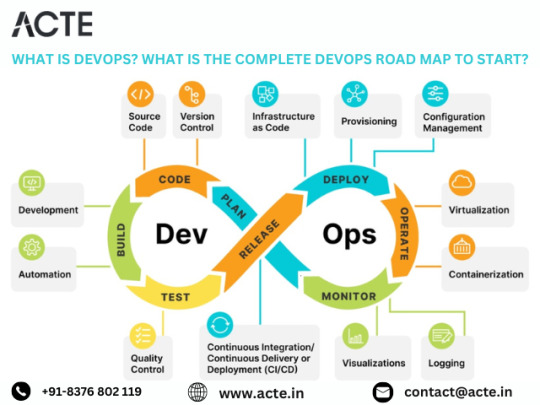
Exploring the Core Tenets of DevOps: DevOps transcends mere toolsets; it embodies a cultural transformation focused on fostering collaboration, automation, and continual enhancement. At its essence, DevOps aims to dismantle barriers between development and operations teams, fostering a culture of shared ownership and continuous improvement.
Grasping Essential Tooling and Technologies: To embark on your DevOps odyssey, familiarizing yourself with the key tools and technologies within the DevOps ecosystem is paramount. From version control systems like Git to continuous integration servers such as Jenkins and containerization platforms like Docker, a diverse array of tools awaits exploration.
Mastery in Automation: Automation serves as the cornerstone of DevOps. By automating routine tasks like code deployment, testing, and infrastructure provisioning, teams can amplify efficiency, minimize errors, and accelerate software delivery. Proficiency in automation tools and scripting languages is imperative for effective DevOps implementation.
Crafting Continuous Integration/Continuous Delivery Pipelines: Continuous Integration (CI) and Continuous Delivery (CD) lie at the heart of DevOps practices. CI/CD pipelines automate the process of integrating code changes, executing tests, and deploying applications, ensuring rapid, reliable, and minimally manual intervention-driven software changes.
Embracing Infrastructure as Code (IaC): Infrastructure as Code (IaC) empowers teams to define and manage infrastructure through code, fostering consistency, scalability, and reproducibility. Treating infrastructure as code enables teams to programmatically provision, configure, and manage infrastructure resources, streamlining deployment workflows.

Fostering Collaboration and Communication: DevOps champions collaboration and communication across development, operations, and other cross-functional teams. By nurturing a culture of shared responsibility, transparency, and feedback, teams can dismantle silos and unite towards common objectives, resulting in accelerated delivery and heightened software quality.
Implementing Monitoring and Feedback Loops: Monitoring and feedback mechanisms are integral facets of DevOps methodologies. Establishing robust monitoring and logging solutions empowers teams to monitor application and infrastructure performance, availability, and security in real-time. Instituting feedback loops enables teams to gather insights and iteratively improve based on user feedback and system metrics.
Embracing Continuous Learning and Growth: DevOps thrives on a culture of continuous learning and improvement. Encouraging experimentation, learning, and knowledge exchange empowers teams to adapt to evolving requirements, technologies, and market dynamics, driving innovation and excellence.
Remaining Current with Industry Dynamics: The DevOps landscape is dynamic, with new tools, technologies, and practices emerging regularly. Staying abreast of industry trends, participating in conferences, webinars, and engaging with the DevOps community are essential for staying ahead. By remaining informed, teams can leverage the latest advancements to enhance their DevOps practices and deliver enhanced value to stakeholders.
Conclusion: DevOps represents a paradigm shift in software development, enabling organizations to achieve greater agility, efficiency, and innovation. By following this comprehensive roadmap and tailoring it to your organization's unique needs, you can embark on a transformative DevOps journey and drive positive change in your software delivery processes.
2 notes
·
View notes
Text
Info copied from linked page :)
WHAT’S GOING ON?
In Fall 2021, the US Congress passed the Infrastructure Investment and Jobs Act (IIJA) amidst significant backlash from the public. The package contained some deeply misguided provisions addressing cryptocurrency that threatened software developers trying to create alternatives to Big Banks and Big Tech. We led much of the opposition through our viral campaign at dontkillcrypto.com and now we’re ready to fight its implementation. Almost two years later on August 29, the US Treasury Department and the Internal Revenue Service (IRS) published their proposed regulations on the sale and exchange of digital assets by brokers as part of their implementation of the IIJA. This rulemaking will define a “digital asset” and who qualifies as a “broker” under the tax code. We have until November 14 to submit comments so we created this page so that individuals can make their voices heard.
What exactly is the new rule being proposed?
The Treasury and IRS want to make a new rule that makes anyone “responsible for regularly providing any service effectuating transfers of digital assets on behalf of another person” a broker. This move would require anyone deemed a broker to collect, keep and report personally-identifiable information from their users (including names, addresses and other financial information via tax forms to the IRS). This makes a lot of sense in the traditional financial (TradFi) world but gets very difficult to implement with decentralized finance (DeFi). It would force DeFi developers who don’t need or want to collect information on their users to do so, thus facilitating government financial surveillance and threatening privacy and anonymity online. Compliance with this rule and its reporting requirements would be impossible. It would essentially be forcing a central point of control where none exists. This could have catastrophic consequences for the decentralized use of digital assets by forcing centralization, creating intermediaries and rendering decentralized technology virtually impossible to access or develop in the U.S.
What are the concerns for the everyday user?
Financial data reveals some of our most sensitive personal information, including our personal interests, the causes we support, and our plans for the future. The agencies’ total failure to consider our privacy rights is outrageous given that this rule would dramatically expand the financial surveillance dragnet.
There is no reason for any of us to believe that these agencies can securely store such a massive collection of sensitive information on millions of people. In 2022, the IRS mistakenly made private information about 120,000 taxpayers publicly available and the Treasury has been hacked in the recent past. Collecting unnecessary information serves no other purpose than to put users at further risk that neither agency can protect them from.
In addition, the Fourth Amendment makes it unconstitutional for the government to force individuals or businesses to collect and report the personal information of others if they (a) don’t already collect that information as part of their business, (b) have no reason to collect that information apart from the government demand, and (c) if the information is not already voluntarily provided. The IRS and Treasury should at the very least, take this opportunity to do the right thing—interpret the statute narrowly and revise this policy accordingly by taking out the requirement for developers to stalk and surveil users of their technologies.
Will this new rule stop tax evasion, money laundering and other serious crimes?
In short, no. People who are operating illegal schemes can continue to use other means. This will not be a miracle fix for problems that exist within traditional finance. Instead, it will cause more issues than it attempts to solve. Similar rules at traditional financial institutions have backfired, allowing these crimes to flourish at some of the world’s biggest, most heavily-regulated banks. If it hasn’t worked before, why would it work now? This rule will effectively impose financial surveillance on people who are participating in the crypto-economy for legitimate purposes, while having little-to-no impact on bad actors.
So, how do I send my comments to the IRS and Treasury?
instagram
Commenters are strongly encouraged to submit public comments electronically. We built this tool to make it easy for everyone to send a comment on this rulemaking. You can use the form above to let the IRS and Treasury know what you think of this new policy. It is very important to add personal stories and insights to really make an impact. You can also submit electronic submissions directly via the Federal eRulemaking Portal at www.regulations.gov, indicate IRS and REG–122793–19 and follow the online instructions for submitting comments. The Treasury Department and the IRS will publish any comments submitted electronically or on paper to the public docket. Once submitted, comments are public and cannot be edited or withdrawn. If necessary, you can also follow the instructions on the page for how to send paper submissions. Written or electronic comments must be received by November 14, 2023.
3 notes
·
View notes
Text
SAP's Role in Building Smart Cities for a Brighter Tomorrow
The globe is quickly urbanizing, and cities face the task of effectively managing resources and services while enhancing citizens' quality of life. Smart cities are developing as the solution to these urban difficulties, fueled by technology and data-driven solutions. In this blog, we'll look at how SAP, a global leader in enterprise software, is transforming cities into smart, sustainable, and networked centres of innovation and advancement.
Deciphering Smart Cities
Before we get into SAP's smart solutions for smart cities contributions, we need define what we mean by "smart cities." These cities use digital technology, data analytics, IoT (Internet of Things), AI (Artificial Intelligence), and cloud computing to improve transportation, energy use, waste management, public safety, and other areas of city life. The main objective is to build urban settings that are responsive, adaptive, and environmentally friendly.
SAP's Impact on Smart Cities
SAP's extensive experience in enterprise software and data management positions it as a key player in the smart city revolution. Here's a closer look at how SAP smart solutions for smart cities is shaping the future of cities:
Data Integration: Smart cities generate vast amounts of data from diverse sources, including sensors, mobile apps, and government systems. SAP's data integration and analytics tools empower cities to efficiently collect, process, and analyze this data in real time. Such smart solutions for smart cities insights prove invaluable for informed decision-making on resource allocation, infrastructure maintenance, and service optimization.

IoT Empowerment: IoT forms the bedrock of smart cities, and SAP's IoT solutions facilitate the seamless connection and management of countless devices and sensors. From smart traffic lights to waste bins, this connectivity allows real-time monitoring and control, enhancing everything from traffic management to environmental sustainability.
Predictive Analytics: SAP's predictive analytics tools enable cities to foresee trends and challenges. For instance, predictive maintenance identifies when critical infrastructure, like bridges or water pipes, may need attention before a major issue arises, saving both time and resources.
Citizen Engagement: Smart cities thrive on citizen involvement in decision-making. SAP provides platforms for citizen engagement, such as mobile apps and online portals, where residents can report issues, take part in surveys, and access information on city services and projects.
Energy Efficiency: Energy management is a top priority for smart cities, and SAP's smart solutions for smart cities help cities monitor and optimize energy consumption in public buildings, street lighting, and other municipal facilities. This smart solutions for smart cities reduces costs and environmental impact.
Conclusion
SAP's essential role in smart city development is assisting cities throughout the world in addressing the complex issues of rising urbanization and resource management. Cities are becoming more efficient, sustainable, and responsive to their inhabitants' demands by leveraging SAP's expertise in data management, IoT, and analytics. The influence of SAP smart business on the future of smart cities is poised to grow as technology progresses, providing more livable, connected, and resilient urban settings for future generations.
3 notes
·
View notes
Link
0 notes
Text
From Flexibility to Security: Unraveling the AWS Advantage
In the ever-evolving landscape of cloud computing, Amazon Web Services (AWS) stands out as a trailblazer, offering a robust and versatile platform that has redefined the way businesses and individuals leverage computing resources. AWS Training in Bangalore further enhances the accessibility and proficiency of individuals and businesses in leveraging the full potential of this powerful cloud platform. With AWS training in Bangalore, professionals can gain the skills and knowledge needed to harness the capabilities of AWS for diverse applications and industries.
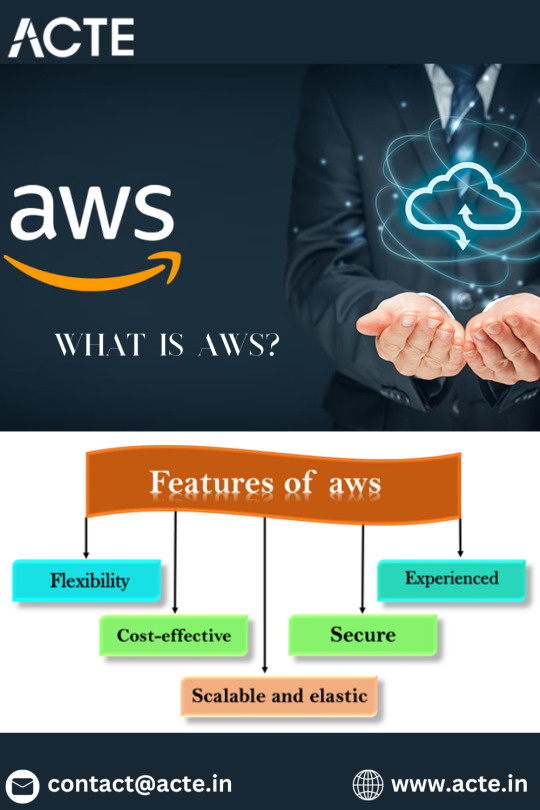
Let's take a closer look at the key aspects that make AWS a cornerstone in the world of cloud computing.
1. Cloud Computing Services for Every Need
At its core, AWS is a comprehensive cloud computing platform that provides a vast array of services. These services encompass Infrastructure as a Service (IaaS), Platform as a Service (PaaS), and Software as a Service (SaaS), offering users a flexible and scalable approach to computing.
2. Scalability and Flexibility
A defining feature of AWS is its scalability. Users have the ability to scale their resources up or down based on demand. This flexibility is particularly advantageous for businesses with varying workloads, allowing them to optimize costs while ensuring optimal performance.
3. Global Infrastructure for Enhanced Performance
AWS operates a global network of data centers known as Availability Zones, strategically located in regions around the world. This geographical diversity enables users to deploy applications and services close to end-users, enhancing performance, and ensuring high availability.
4. Emphasis on Security and Compliance
Security is a top priority for AWS. The platform offers robust security features, including data encryption, identity and access management, and compliance with various industry standards and regulations. This commitment to security instills confidence in users, especially those handling sensitive data.
5. Cost-Efficiency at Its Core
AWS follows a pay-as-you-go pricing model, allowing users to pay only for the resources they consume. This cost-efficient approach makes AWS accessible to startups, small businesses, and enterprises alike, eliminating the need for significant upfront investments.
6. Comprehensive Service Offerings
AWS boasts an extensive portfolio of services, covering computing, storage, databases, machine learning, analytics, IoT, security, and more. This diversity empowers users to build, deploy, and manage applications for virtually any purpose, making AWS a one-stop-shop for a wide range of computing needs.
7. Vibrant Ecosystem and Community
The AWS ecosystem is vibrant and dynamic, supported by a large community of users, developers, and partners. This ecosystem includes a marketplace for third-party applications and services, as well as a wealth of documentation, tutorials, and forums that foster collaboration and support.
8. Enterprise-Grade Reliability
The reliability of AWS is paramount, attracting the trust of many large enterprises, startups, and government organizations. Its redundant architecture and robust infrastructure contribute to high availability and fault tolerance, crucial for mission-critical applications.
9. Continuous Innovation
Innovation is ingrained in the AWS DNA. The platform consistently introduces new features and services to address evolving industry needs and technological advancements. Staying at the forefront of innovation ensures that AWS users have access to cutting-edge tools and capabilities.
10. Facilitating DevOps and Automation
AWS supports DevOps practices, empowering organizations to automate processes and streamline development workflows. This emphasis on automation contributes to faster and more efficient software delivery, aligning with modern development practices.

In conclusion, Amazon Web Services (AWS) stands as a powerhouse in the cloud computing arena. Its scalability, security features, and extensive service offerings make it a preferred choice for organizations seeking to harness the benefits of cloud technology. Whether you're a startup, a small business, or a large enterprise, AWS provides the tools and resources to propel your digital initiatives forward. As the cloud computing landscape continues to evolve, AWS remains a stalwart, driving innovation and empowering users to build and scale with confidence. To master the intricacies of AWS and unlock its full potential, individuals can benefit from enrolling in the Best AWS Training Institute. This training ensures that professionals gain the expertise needed to navigate the complexities of AWS, empowering them to contribute effectively to their organizations' digital transformation and success.
2 notes
·
View notes
Text
Embracing DevOps: A Journey Towards Technological Excellence
In the ever-evolving landscape of modern technology, where change is the only constant, DevOps has emerged as a revolutionary force reshaping the very foundations of software development and IT operations. Short for Development and Operations, DevOps represents not just a set of practices, but an all-encompassing cultural shift with far-reaching implications in the digital age.
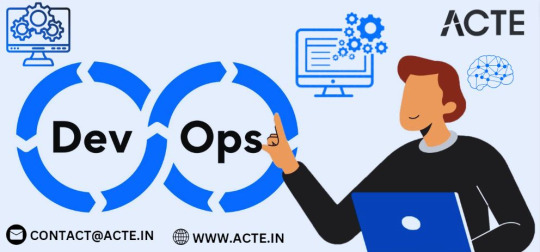
This comprehensive blog invites you to embark on an immersive journey into the expansive universe of DevOps. Here, we dive deep into the multifaceted scope of DevOps and its transformative impact across diverse industries. From turbocharging software delivery to fortifying security and scalability, DevOps isn't just a methodology; it's the cornerstone of success in today's interconnected technological landscape.
Join us as we unravel the boundless possibilities and profound significance of DevOps in the modern tech-driven world.
Unveiling the Multifaceted Scope of DevOps
DevOps isn't a singular concept or a one-size-fits-all approach; it's a dynamic and multifaceted philosophy that touches every facet of modern technology. Let's delve into the various dimensions that collectively define the expansive scope of DevOps:
Streamlined Software Delivery: In a world where time is a valuable currency, DevOps assumes center stage. It empowers organizations to expedite the development, testing, and deployment of software, resulting in swift and efficient software releases, a decisive advantage in today's fast-paced business landscape.
Enhanced Collaboration: DevOps shatters traditional silos that once separated development and operations teams. Instead, it nurtures a culture of collaboration, where every team member works harmoniously toward common objectives, fostering superior outcomes and a culture of relentless innovation.
Continuous Integration and Continuous Delivery (CI/CD): DevOps champions the widespread adoption of CI/CD pipelines, where the process of building, testing, and deploying code becomes an automated symphony. This not only reduces errors but also accelerates the delivery of new features and updates, keeping organizations agile and competitive.
Improved Quality: Quality is the keystone of DevOps. Through automated testing and continuous monitoring, DevOps ensures that software maintains an apex of quality. Issues are pinpointed and rectified early in the development cycle, dramatically lowering the chances of post-production glitches.
Efficient Resource Utilization: DevOps practices become the maestros of resource optimization, eliminating inefficiencies in both time and infrastructure. The result? Cost savings and a more efficient utilization of resources, a double boon for organizations.
Enhanced Security: Security isn't an afterthought in DevOps; it's integrated seamlessly into the very fabric of the process. Automated security scans and checks are an integral part, ensuring proactive measures are taken to minimize vulnerabilities and bolster system security.
Scalability: DevOps, by its very nature, is infinitely scalable. It empowers organizations to seamlessly adjust their operations to meet demand, whether scaling up or down. DevOps ensures that systems can adeptly handle varying workloads, providing the vital elements of flexibility and efficiency.
Monitoring and Feedback: At the core of DevOps lie the principles of continuous monitoring and feedback loops. This guarantees that performance issues are swiftly identified, enabling teams to make necessary adjustments in real-time, further enhancing efficiency.
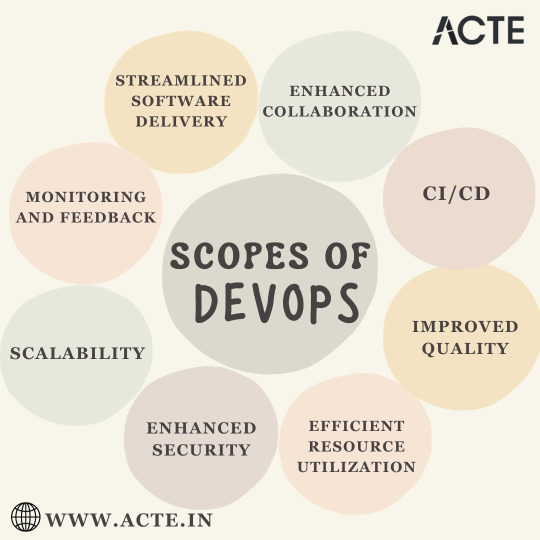
The DevOps Revolution Across Industries:
The scope of DevOps extends beyond the boundaries of industries, leaving its indelible mark in software development, e-commerce, finance, healthcare, and beyond. Its principles and practices are proven to be versatile and adaptable, positioning DevOps as a coveted asset in the world of technology. It drives innovation and efficiency in every sector fortunate enough to embrace it.
In the vast landscape of technology, DevOps has emerged as a beacon of efficiency and innovation. It's not merely a practice; it's a transformative culture that redefines how organizations approach software development and IT operations. With streamlined software delivery, enhanced collaboration, continuous integration and delivery, improved quality, efficient resource utilization, enhanced security, scalability, and vigilant monitoring, DevOps has left an indelible mark across industries.
The scope of DevOps transcends boundaries, impacting software development, e-commerce, finance, healthcare, and beyond. Its principles and practices adapt and evolve, making DevOps an invaluable asset in the world of technology, driving innovation and efficiency wherever it is embraced.
In a world where adaptability and agility are paramount, DevOps shines as an irreplaceable force. And in this dynamic landscape, ACTE Technologies stands as a guiding light, preparing individuals to excel in DevOps. With the rise in demand for skilled DevOps professionals, ACTE Technologies equips learners with the knowledge and practical skills needed to thrive in this dynamic domain. Whether you're a budding DevOps engineer or a seasoned IT professional, embracing DevOps isn't just a career choice; it's a monumental leap towards a promising and impactful future in the tech industry. The possibilities with DevOps are limitless, and the journey ahead is filled with innovation and success.
8 notes
·
View notes
Text
Full Stack Development: Using DevOps and Agile Practices for Success
In today’s fast-paced and highly competitive tech industry, the demand for Full Stack Developers is steadily on the rise. These versatile professionals possess a unique blend of skills that enable them to handle both the front-end and back-end aspects of software development. However, to excel in this role and meet the ever-evolving demands of modern software development, Full Stack Developers are increasingly turning to DevOps and Agile practices. In this comprehensive guide, we will explore how the combination of Full Stack Development with DevOps and Agile methodologies can lead to unparalleled success in the world of software development.
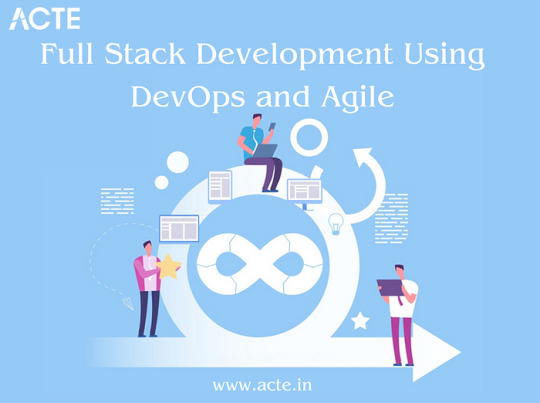
Full Stack Development: A Brief Overview
Full Stack Development refers to the practice of working on all aspects of a software application, from the user interface (UI) and user experience (UX) on the front end to server-side scripting, databases, and infrastructure on the back end. It requires a broad skill set and the ability to handle various technologies and programming languages.
The Significance of DevOps and Agile Practices
The environment for software development has changed significantly in recent years. The adoption of DevOps and Agile practices has become a cornerstone of modern software development. DevOps focuses on automating and streamlining the development and deployment processes, while Agile methodologies promote collaboration, flexibility, and iterative development. Together, they offer a powerful approach to software development that enhances efficiency, quality, and project success. In this blog, we will delve into the following key areas:
Understanding Full Stack Development
Defining Full Stack Development
We will start by defining Full Stack Development and elucidating its pivotal role in creating end-to-end solutions. Full Stack Developers are akin to the Swiss Army knives of the development world, capable of handling every aspect of a project.
Key Responsibilities of a Full Stack Developer
We will explore the multifaceted responsibilities of Full Stack Developers, from designing user interfaces to managing databases and everything in between. Understanding these responsibilities is crucial to grasping the challenges they face.
DevOps’s Importance in Full Stack Development
Unpacking DevOps
A collection of principles known as DevOps aims to eliminate the divide between development and operations teams. We will delve into what DevOps entails and why it matters in Full Stack Development. The benefits of embracing DevOps principles will also be discussed.
Agile Methodologies in Full Stack Development
Introducing Agile Methodologies
Agile methodologies like Scrum and Kanban have gained immense popularity due to their effectiveness in fostering collaboration and adaptability. We will introduce these methodologies and explain how they enhance project management and teamwork in Full Stack Development.

Synergy Between DevOps and Agile
The Power of Collaboration
We will highlight how DevOps and Agile practices complement each other, creating a synergy that streamlines the entire development process. By aligning development, testing, and deployment, this synergy results in faster delivery and higher-quality software.
Tools and Technologies for DevOps in Full Stack Development
Essential DevOps Tools
DevOps relies on a suite of tools and technologies, such as Jenkins, Docker, and Kubernetes, to automate and manage various aspects of the development pipeline. We will provide an overview of these tools and explain how they can be harnessed in Full Stack Development projects.

Implementing Agile in Full Stack Projects
Agile Implementation Strategies
We will delve into practical strategies for implementing Agile methodologies in Full Stack projects. Topics will include sprint planning, backlog management, and conducting effective stand-up meetings.
Best Practices for Agile Integration
We will share best practices for incorporating Agile principles into Full Stack Development, ensuring that projects are nimble, adaptable, and responsive to changing requirements.
Learning Resources and Real-World Examples
To gain a deeper understanding, ACTE Institute present case studies and real-world examples of successful Full Stack Development projects that leveraged DevOps and Agile practices. These stories will offer valuable insights into best practices and lessons learned. Consider enrolling in accredited full stack developer training course to increase your full stack proficiency.
Challenges and Solutions
Addressing Common Challenges
No journey is without its obstacles, and Full Stack Developers using DevOps and Agile practices may encounter challenges. We will identify these common roadblocks and provide practical solutions and tips for overcoming them.
Benefits and Outcomes
The Fruits of Collaboration
In this section, we will discuss the tangible benefits and outcomes of integrating DevOps and Agile practices in Full Stack projects. Faster development cycles, improved product quality, and enhanced customer satisfaction are among the rewards.
In conclusion, this blog has explored the dynamic world of Full Stack Development and the pivotal role that DevOps and Agile practices play in achieving success in this field. Full Stack Developers are at the forefront of innovation, and by embracing these methodologies, they can enhance their efficiency, drive project success, and stay ahead in the ever-evolving tech landscape. We emphasize the importance of continuous learning and adaptation, as the tech industry continually evolves. DevOps and Agile practices provide a foundation for success, and we encourage readers to explore further resources, courses, and communities to foster their growth as Full Stack Developers. By doing so, they can contribute to the development of cutting-edge solutions and make a lasting impact in the world of software development.
#web development#full stack developer#devops#agile#education#information#technology#full stack web development#innovation
2 notes
·
View notes
Text
Advantages and disadvantages of 5G

5G technology or fifth generation technology offers many features for mobile networks. It is useful for government, students, businesses and professionals. It is a new mobile network designed to connect everyone and everything. It is the new standard in global wireless networks after 1G to 4G. It offers high multi-Gbps data speeds, low latency, large network capacity, and a flexible user experience. As this new technology is deployed, 5G technology should create many new applications.
5G technology features in brief. Speed up to 10 Gbits.
Great app
100 times more device connections
Fast response time
Waste of time
Another software option to upgrade. Great potential
With the proliferation of digital around the world, when live streaming and games, sports, news, movie reviews, social media, etc., the transfer of large amounts of data from one host to another and the Internet of Things (IoT) spurred the development of mobile phone standards. .
However, the 5G technology network has not yet reached its potential because the existing devices and infrastructure are not yet ready to support the 5G technology network. Those who have tested the 5G technology network using it with built-in 4G devices in this application are also called non-stationary 5G technology networks. The full potential of 5G technology will only be realized when independent networks, compatible devices and better communication tower technologies become available.
Advantages of 5G technology
Transfer data faster
The previous generation 4G LTE technology used bands below 3 GHz but in comparison, 5G technology uses bandwidth from 6 GHz in length to 24 GHz. However, it is important to note that 5G technology coverage also requires a base station and a broadcast tower compared to a 4G data network.
Improved network
5G networks are more flexible as they work with different customers, services and market segments. It divides its network in such a way that it will adapt to the needs of the users. It is based on Network Functions Virtualization (NFV) and Software Defined Networking (SDN). It is also called a "network fragment". This provides high data rates, low power consumption, and reliable low latency.
Moving Beamforming
Moving Beamforming refers to a radio signal processing technique that allows for the transmission or reception of a directional network, unlike a passive antenna that beams the signal randomly in all directions. 4G networks also use beamforming to some capacity, but in a growing sense.
Benefits for companies and businesses
It provides improved machine-to-machine communication for automation, real-time communication and guaranteed network availability, digitization of healthcare and agricultural industries.
Benefits for consumers
It provides fast download and download times when you are streaming users. Stable connection to mobile communications, low response time for online or cloud gaming, virtual reality, high quality live TV and 4K video telephony.
A more secure network
5G technology networks offer more security than previous generation networks. It supports protection against data loss, data corruption and theft. The exchange of sensitive and private customer data, such as hospital patient reports, customer data and student information at universities, is more secure in the 5G technology network.
Disadvantages of 5G
Limit coverage
The 5G technology network is a new technology, it requires a large network of ports and transmission towers worldwide, which requires a lot of time, testing, testing and setting up 5G technology towers.
Reduces durability
If the experts are to be believed, the non-standard 5G technology network undermines the performance of 4G network devices. Although a few manufacturers have started to produce 5G technology network devices, R & D believes that due to high data transmission in the largest network, the longevity or service life of mobile phones and other devices will be compromised.
Involvement in aviation
In January, Air India cancled several flights to the United States because they were rolling out 5G technology services in the country. This is a major setback of 5G technology in India as airlines have suffered losses due to ongoing 5G technology deployment projects. It can also be a hindrance in the future if not dealt with quickly. Internet Security Threats
Although the 5G technology network is said to help improve cybersecurity, it also has its limitations as it encourages cloud computing and exposes more data to risk. of hacking due to its lack of privacy and ease of access to network networks. on the other hand. hands
5G technologyin India
India officially launched its 5G technology network in October this year at an event held in New Delhi. Airtel and Jio have started rolling out 5G technology data plans in select state. However, Vodafone Idea is not planning to launch it in the near future.
In case of Airtel, they are currently placed in Tier I to Tier 8 countries. Jio has launched 5G technology services in limited areas. Many telecom operators are also of the opinion that pan-India 5G technology network coverage will take a few years. Jio recently announced after the 5G technology beta test that no SIM card is required to operate Jio's 5G technology network. However, Vodafone Idea has not yet announced its 5G technology network.
The health risks of 5G technology and the disadvantages of 5G technology for the environment
The International Commission on Non-ionizing Radiation Protection (ICNIRP) has stated that increasing radio frequencies above 6 GHz may have biological and health effects. The 5G technology network will increase the amount of electromagnetic radiation in the environment, causing a greater risk of cancer. With the lack of power of 5G technology network devices, there will also be an increase in the collection of electronic waste. The electric current from the cell tower exposed sparrows and other birds to increased egg production and nesting behavior. High rates of energy consumption have also contributed to global warming.
7 notes
·
View notes
Text
5 tips to Setup Best Project Management Office
Project management offices (PMOs) are a crucial component of an organization's strategy to manage projects, programs, and portfolios effectively. The purpose of a PMO is to ensure that projects are aligned with the organization's objectives, are completed on time, within budget, and to the desired quality. This article provides five tips to help organizations set up an effective PMO.

1.Define the Purpose and Scope of the PMO
The first step in setting up a PMO is to define its purpose and scope. This involves identifying the specific goals and objectives of the PMO, as well as the types of projects and programs it will manage. This clarity of purpose will guide the development of the PMO's charter, policies, and processes, and will ensure that everyone involved in the PMO understands its role and responsibilities.
2.Assign Roles and Responsibilities
Once the purpose and scope of the PMO have been defined, it is important to assign roles and responsibilities to the PMO team members. This includes defining the roles and responsibilities of the PMO Director, project managers, and support staff, as well as the relationships between the PMO and other parts of the organization.
3.Establish PMO Processes and Procedures
The PMO's success is dependent on the establishment of effective processes and procedures. This includes the development of project management methodologies, templates, and tools, as well as the definition of project management standards, policies, and guidelines. The PMO should also establish a governance structure to oversee the project portfolio, and provide regular reporting and metrics to measure the PMO's performance.
4.Implement Project Management Software
The PMO should implement a project management software solution to support its operations. This will enable the PMO to manage projects and programs effectively, streamline processes, and improve collaboration and communication among team members. The software should be flexible and customizable, to meet the specific needs of the PMO, and should include features such as project planning, scheduling, budgeting, risk management, and status reporting.
5.Provide Training and Support
The PMO should provide training and support to project managers and other staff members to ensure that they are equipped to carry out their responsibilities effectively. This includes training in project management methodologies and best practices, as well as training in the use of project management software and other tools. The PMO should also provide ongoing support to project managers, to help them overcome challenges and ensure project success.
Conclusion
Setting up an effective PMO is a complex process that requires careful planning and execution. By following these five tips, organizations can ensure that their PMO is well-positioned to support the successful delivery of projects and programs, and to achieve its goals and objectives. The PMO is a critical component of an organization's project management infrastructure, and it is essential that it is set up and managed in a way that maximizes its value to the organization.
7 notes
·
View notes